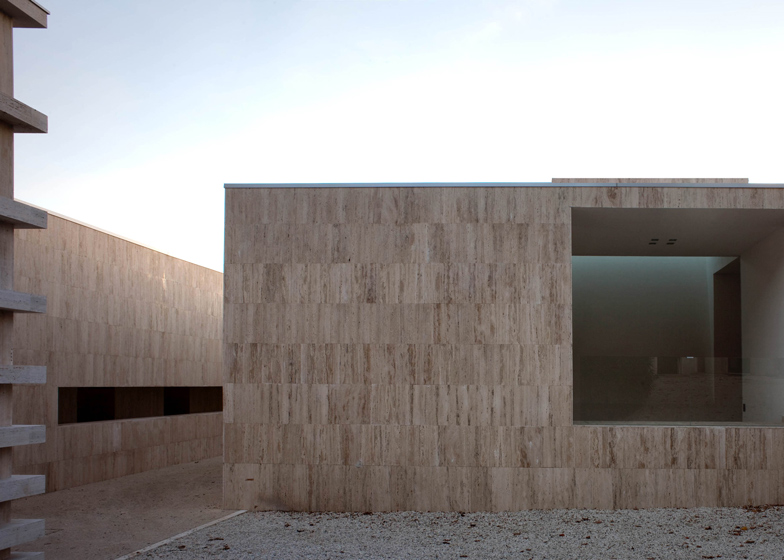Italian architect Andrea Dragoni has extended a cemetery in an ancient Italian town by adding rows of monumental travertine walls with public plazas and artworks slotted in between (+ slideshow).
Andrea Dragoni was tasked with adding a new tract to the historic Gubbio necropolis, which is located just outside the town at the base of Mount Ingino in the Apennines.
The towering stone walls are laid out in sequence, intended by the architect to reflect the linear arrangement of the old town and its surrounding landscape.
"The contrast between void and solid resumes the rhythms found in the medieval town of Gubbio," Dragoni told Dezeen. "The voids in this composition, as in many of my projects, play a central role. They become architecture with a strong poetic and spiritual reaction."
Four equally sized courtyards are positioned at intervals between the walls. Italian artists Sauro Cardinali and Nicola Renzi created large site-specific artworks to occupy each one, plus large square skylights were added to frame views up to the sky.
"These spaces were inspired by James Turrell's Skyspaces and are designed to be enjoyable public areas, independent from the cemetery, offering an opportunity to pause and reflect," said the architect.
"The sky thus framed opens the mind to the reign of the invisible, allowing sight and thought to abandon Mother Earth's gravity and acquire a more aerial and spiritual dimension," he added.
Walls and floors are made from travertine - a form of limestone typically used in Italian architecture - and contrast with the brick structures of the original complex that can be spotted through one of the central corridors.
"Travertine was used by the Etruscans for all the most important public buildings of the Renaissance," said Dragoni. "It is a tribute to this tradition that I wanted to reinterpret the material to emphasise the gravity of the volumes of the cemetery and their strong abstraction."
Photography is by Alessandra Chemollo, apart from where otherwise stated.
Read on for a project description from Andrea Dragoni:
Extension of Gubbio Cemetery
The enlargement of the Gubbio cemetery is the result of studies of a new model of public building. On the one hand, it has developed the latest phase of growth of the monumental cemetery in Gubbio, one of Italy's most important medieval cities. On the other hand, it intends to redefine its meaning and centrality within the structure of the city.
The plan is in an urban structure consisting of linear stereometric blocks arranged in such a way as to reflect the rural layouts that characterise the surrounding landscape and the historic city.
This concept of urban settlement is emphasised by the inclusion of large square enclosures designed to be open spaces that provide the structure with spatial rhythm.
These spaces were inspired by James Turrell's Skyspaces and are designed to be enjoyable public areas, independently from the cemetery, offering an opportunity to pause and reflect. These are cubic "squares of silence" having open ceilings that evoke windows open to the sky. The sky thus framed opens the mind to the reign of the invisible, allowing sight and thought to abandon Mother Earth's gravity and acquire a more aerial and spiritual dimension.
This relationship with the sky intends to define space that is also time, in such a way that you can find yourself again, a space that thrusts the horizon upwards like a metaphor of the boundaries of heaven, the last horizon of our life in a modern city.
At the same time, opening to the sky, it re-interprets Leon Battista Alberti's window, a window that is like a threshold, imagined by the great Renaissance architect as the only architectural artifice able to "instil the peacefulness" evoked by the celestial void that, descending from above, takes us back to the imperturbable state of the soul without which overcoming the adversities of life is impossible.
The atmosphere of these "squares of silence" is made more suggestive by a series of permanent site-specific artistic installations that capture the changing effects of light and shadow from dawn to dusk. These installations were created by two important Italian artists (Sauro Cardinali and Nicola Renzi), with whom collaboration began during the initial stage of the project.
This contribution, strongly linked with architecture, helps to define a new space for silence and meditation within the city.
William Richard Lethaby said that human beings cannot understand the world as a whole. They must first move away from it, and only after having achieved this detachment can they achieve understanding.
In this sense a building can be seen as a model of the world; it represents an order we cannot directly experience in the world, but at the same time it makes perceptible, within the limits of a building, that which exists in the world.
Project: Andrea Dragoni, with Francesco Pes
Collaborators: Andrea Moscetti Castellani, Giorgio Bettelli, Michela Donini, Raul Cambiotti, Antonio Ragnacci, Cristian Cretaro, Matteo Scoccia
Client: Comune di Gubbio
Site-specific art work: Sauro Cardinali, Nicola Renzi
Structural design: Giuseppe Artegiani, Marco Bacchi
Plants Design: Italprogetti (Moreno Dorillo, Elvisio Regni)
Safety coordination: Claudio Pannacci
Director of works: Francesco Pes, Paolo Bottegoni
Maquette: Giuseppe Fioroni













